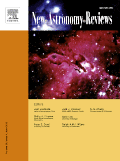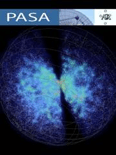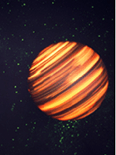
REVISTA MEXICANA DE ASTRONOMIA Y ASTROFISICA
metrics 2024
Exploring the Depths of Space and Time
Introduction
Revista Mexicana de Astronomía y Astrofísica, published by the Universidad Nacional Autónoma de México (INSTITUTO DE ASTRONOMÍA), is a prominent academic journal dedicated to advancing the knowledge and understanding of astronomy and astrophysics. As a Q3-ranked journal in both Astronomy and Astrophysics, and Space and Planetary Science in 2023, it serves as an invaluable platform for researchers and professionals within these fields. With an ISSN of 0185-1101, this journal seeks to foster innovative research and dialogue among scholars, presenting groundbreaking studies spanning from theoretical astrophysics to observational astronomy. Although it does not operate under an open-access model, the journal remains vital for its contributions to scientific literature from Mexico, with articles converging over several decades from 1996 to 2024. By offering insights into the latest findings and methodologies, Revista Mexicana de Astronomía y Astrofísica not only enhances the academic landscape but also inspires future generations of scientists and students passionate about unraveling the mysteries of the universe.
Metrics 2024
 0.30
0.30 1.10
1.10 0.90
0.90 33
33Metrics History
Rank 2024
Scopus
IF (Web Of Science)
JCI (Web Of Science)
Quartile History
Similar Journals

NEW ASTRONOMY REVIEWS
Unveiling the Universe: Comprehensive Reviews for the Curious MindNEW ASTRONOMY REVIEWS, published by Elsevier Science Ltd, stands as a premier journal in the field of Astronomy and Astrophysics as well as Space and Planetary Science. Established in 1998 and operating until 2024, this journal has consistently maintained a distinguished reputation, reflected in its Q1 categorization in both subject areas for 2023. It holds an impressive Scopus ranking, placed #6 out of 104 in Earth and Planetary Sciences and #7 out of 90 in Physics and Astronomy, showcasing its critical impact with a percentile rank of 94th and 92nd, respectively. Although not an open access journal, it provides vital insights and comprehensive reviews that are essential for researchers, professionals, and students eager to advance their knowledge in contemporary astronomical research and theories. With rigorous peer review and a commitment to high-quality publications, NEW ASTRONOMY REVIEWS is an indispensable resource for the scientific community striving to uncover the mysteries of the universe.

PUBLICATIONS OF THE ASTRONOMICAL SOCIETY OF AUSTRALIA
Illuminating the Universe Through Scholarly Excellence.Publications of the Astronomical Society of Australia, published by Cambridge University Press, stands as a distinguished platform for advancing knowledge in the realms of Astronomy, Astrophysics, Space, and Planetary Science. Hemmed in the United Kingdom, this journal is recognized for its outstanding contributions, reflected in its status as a Q1 journal in both Astronomy and Astrophysics, along with Space and Planetary Science categories as of 2023. With a solid impact factor, it ranks impressively at #23 within its Scopus category, firmly placing it in the competitive 75th percentile. This publication facilitates open discourse and innovative research from its inception in 1996 to the present year of 2024, providing an essential resource for researchers, professionals, and students eager to deepen their understanding of cosmic phenomena. By embracing rigorous peer-review standards and a commitment to scholarly excellence, the journal not only contributes to the scientific community but also fosters the next generation of astronomical research.

ASTROPHYSICS
Shaping the Future: Essential Research in Astronomy and AstrophysicsASTROPHYSICS, published by Springer/Plenum Publishers, stands as a crucial platform for the dissemination of groundbreaking research in the field of Astronomy and Astrophysics. Established in 1965 and continuing its legacy until 2024, the journal highlights significant advancements, theoretical frameworks, and observational data that collectively push the boundaries of our understanding of the universe. Although currently categorized in the Q4 quartile for Astronomy and Astrophysics and holding a Scopus rank within the 17th percentile, ASTROPHYSICS remains dedicated to offering rigorous peer-reviewed content that is essential for researchers, professionals, and students alike. While it does not provide open access, the journal's accessibility through institutional subscriptions ensures a wide reach among the academic community, allowing it to address the rising curiosity surrounding cosmic phenomena and contribute meaningfully to ongoing scholarly discourse. For those seeking to engage with the latest findings and methodologies in astrophysics, ASTROPHYSICS continues to serve as an indispensable resource.

Annual Review of Astronomy and Astrophysics
Exploring the cosmos, one review at a time.Annual Review of Astronomy and Astrophysics is a premier academic journal published by Annual Reviews, dedicated to advancing knowledge in the fields of astronomy and astrophysics. With an impressive impact factor and recognition as a Q1 journal in both Astronomy and Astrophysics, as well as Space and Planetary Science, it stands amongst the top-ranked publications globally with Scopus Rankings placing it in the 99th percentile. The journal spans over three decades of scholarly contributions from 1990 to 2023, creating a rich repository of knowledge for researchers, professionals, and students alike. Although it does not offer Open Access, its rigorous peer-review process ensures the utmost quality and relevance of published articles, making it an essential resource for anyone seeking to stay at the forefront of developments in the cosmos. With its dedication to covering the forefront of research and essential reviews, the Annual Review of Astronomy and Astrophysics is vital for those engaged in exploring the universe and its phenomena.

PUBLICATIONS OF THE ASTRONOMICAL SOCIETY OF JAPAN
Illuminating the cosmos with cutting-edge discoveries.Publications of the Astronomical Society of Japan is a prestigious, peer-reviewed journal dedicated to advancing the field of astronomy and astrophysics. Published by Oxford University Press, this journal provides a platform for high-quality research, fostering scientific communication among both established researchers and emerging scholars. With an ISSN of 0004-6264 and E-ISSN 2053-051X, it is recognized for its significant impact in its field, boasting a Q2 ranking in both Astronomy and Astrophysics and Space and Planetary Science as of 2023. The journal seeks to bridge traditional and innovative approaches to expand understanding of celestial phenomena, making it an essential resource for professionals, students, and researchers alike. Researchers can access a wealth of cutting-edge studies spanning theoretical and observational aspects of astronomy from its inception in 1996 to the present day. Although the journal operates under a traditional access model, it remains a respected forum for pivotal discoveries and discussions within the global astronomical community.

Kinematics and Physics of Celestial Bodies
Pioneering Research in Celestial DynamicsKinematics and Physics of Celestial Bodies is a prominent journal published by PLEIADES PUBLISHING INC, dedicated to the exploration and understanding of celestial mechanics and the physical properties of astronomical bodies. With an ISSN of 0884-5913 and an E-ISSN of 1934-8401, this journal has established itself as a resource for researchers in the fields of astronomy, astrophysics, and space science since its inception in 2009. The journal is indexed in Scopus, where it currently ranks in the fourth quartile for both Astronomy and Astrophysics and Space and Planetary Science, making it a valuable platform for scholarly discourse despite its ranking. Its scope encompasses a range of topics related to the kinematics and physical characteristics of celestial objects, aiming to facilitate a better understanding of their dynamics and interactions within the universe. Although it does not operate under an open access model, the journal provides essential insights and findings, catering to the academic needs of researchers, professionals, and students engaged in the study of the cosmos. The journal's commitment to advancing knowledge in the various aspects of celestial physics ultimately contributes to the broader scientific community's endeavors.

MONTHLY NOTICES OF THE ROYAL ASTRONOMICAL SOCIETY
Pioneering Insights in Space and Planetary Science.The MONTHLY NOTICES OF THE ROYAL ASTRONOMICAL SOCIETY (MNRAS), published by Oxford University Press, serves as a premier platform for the dissemination of significant research in the fields of Astronomy, Astrophysics, and Space and Planetary Science. Established in 1913 and with an impressive impact factor reflected in its 2023 Q1 rankings—13th in Earth and Planetary Sciences and 14th in Physics and Astronomy—this journal is renowned for its rigorous peer-reviewed articles, fostering advancements in our understanding of the universe. Researchers, professionals, and students alike benefit from its rich content, which spans a vast array of topics within its scope, from stellar dynamics to planetary formation. While the journal does not currently offer Open Access options, the scholarly contributions published herein are invaluable for pushing the boundaries of contemporary scientific inquiry and ensuring that the latest findings reach an engaged audience globally.

Galaxies
Fostering innovation in the study of the cosmos.Galaxies, published by MDPI, is a premier open-access journal dedicated to the vibrant field of Astronomy and Astrophysics. Established in 2013, with a strong commitment to making scientific research accessible, this journal has quickly garnered recognition, achieving a notable impact factor and ranking in the Q2 Quartile of its category as of 2023. With a Scopus ranking of #31 out of 90 in the domain of Astronomy and Astrophysics, and a commendable percentile rank of 66, Galaxies serves as a vital platform for researchers, professionals, and students engaged in astronomical studies and related fields, facilitating the dissemination and discussion of groundbreaking research. The journal covers a wide array of topics including galactic dynamics, cosmology, and observational astronomy, encouraging interdisciplinary collaboration and innovation within the scientific community. Located in Basel, Switzerland, and adhering to the highest publishing standards, Galaxies is committed to enriching the academic discourse in astronomy, making a significant impact on both current and future explorations of our universe.

JOURNAL OF ASTROPHYSICS AND ASTRONOMY
Advancing Knowledge in Celestial Science.JOURNAL OF ASTROPHYSICS AND ASTRONOMY, published by the Indian Academy of Sciences, stands as a pivotal resource for researchers and professionals in the fields of astrophysics and astronomy, with a rich history of publication dating back to 1980. This esteemed journal aims to disseminate high-quality research, fostering advancements in how we understand celestial phenomena, space environments, and planetary sciences. With a current Impact Factor that places it in the Q3 category for both Astronomy and Astrophysics and Space and Planetary Science, it maintains a crucial role in the global academic community, particularly within India. Although not an open access journal, its scholarly contributions are vital for both emerging and established researchers striving to push the boundaries of our knowledge in the cosmos. The journal is indexed in Scopus, ranking 56th in Astronomy and Astrophysics and 72nd in Space and Planetary Science, reflecting its ongoing significance and reach in the scientific dialogue.

Romanian Astronomical Journal
Bridging tradition and innovation in astronomical studies.Welcome to the Romanian Astronomical Journal, a distinguished publication operating under the esteemed EDITURA ACAD ROMANE, dedicated to advancing the field of Astronomy and Astrophysics. With a rich tradition rooted in Romania, this journal aims to foster scholarly discourse and disseminate pivotal research findings within the cosmic sciences. Although currently not designated as Open Access, the journal remains committed to ensuring that its content meets rigorous academic standards. The Romanian Astronomical Journal holds a commendable position in the academic community, achieving a Q3 ranking in Astronomy and Astrophysics and a Q4 ranking in Space and Planetary Science for 2023, reflecting its contribution to the scientific landscape. With a focus on originality and scholarly excellence, this journal serves as a vital resource for researchers, professionals, and students alike, promoting a deeper understanding of the universe and our place within it. Positioned at the intersection of innovative research and practical application, the Romanian Astronomical Journal invites contributions that push the boundaries of knowledge in our field.